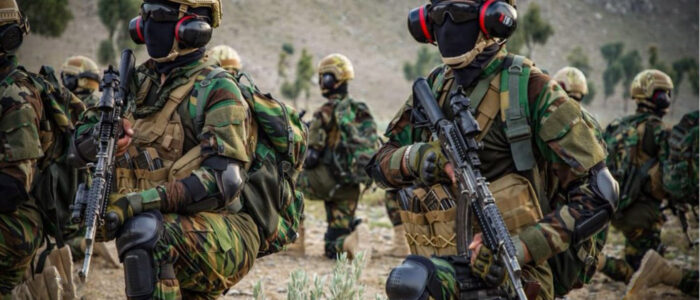Observing the Taliban’s stronghold in Afghanistan, many political and strategic analysts believe that the Afghan Taliban is sturdier today than its prior leverage in the past. Primarily, their security and political dynamics seem altered after pulling out the United States (U.S.) and its ‘allies’ troops from the Afghan soil. However, a newly emerged special force, Badri 313 battalion of the Taliban, has come to the forefront days earlier when the Taliban released video footage to solidify their strength and show their readiness in combat. In addition, the unit has been notable for carrying out suicide operations against the opposing forces.
As a special commando unit, Badri 313 battalion is tasked with safeguarding the capital territory of Afghanistan and other important sites captured by the Taliban fighters in the country. The videos and pictures released by the Taliban-linked social media display that they are well fortified with state-of-the-art military hardware and modern weapons. Dressed in modern combat fatigues rather than typical long shirts and baggy trousers, the brigade uses the U.S. and its allied ‘militaries’ weapons and equipment seized as booty of war. The U.S. M4 carbine assault rifles and American style helmets with night vision mount, tactical military sunglasses, body armours, tactical radios and knee pads, combat boots and armoured Humvee vehicles are shown in several pictures.
The name ‘Badri ‘313’ is taken from one of the historical battles of Islam – Gazwa-e-Badr (the battle of Badr), a major military triumph for Muslim ummah (community) in 624 C.E. where Muhammad, the last Prophet of Islam, defeated larger enemy forces with 313 Muslim warriors.
It is reported that Badri 313 commandos are highly trained who have benefited from the Haqqani Network’s training and have conducted numerous covert operations across the country against the U.S. military and former Afghan National Defence and Security Forces (ANDSF). But, the exact numerical strength of the battalion has not been disclosed yet.
Today, the success and strength of the Taliban can be associated with the U.S. and NATO forces own fault lines and their unfitting strategy during combat with the Taliban. The power behind the Emirate’s commando can be perceived as a consequence of the US’s over weaponisation of the region during the last two decades and have left sophisticated weapons and high-tech equipment in the hands of the Taliban. As per the US officials’ estimate, approximately $28 billion worth of weaponry provided by the US to the Afghan security forces between 2002 and 2017 is now at the disposal of the Taliban. It seems what the Mujahideen did to the Soviet Union’s forces four decades ago, defeated them with their own weapons, the Taliban has done the same to the U.S. forces. An inappropriate capacity building of the ANDSF and a poorly executed withdrawal plan beefed up the Taliban forces. Several combat helicopters and light fighter aircraft including 35 American Sikorsky UH-60 Black Hawk helicopters are now in the Taliban’s control. The US and its allies also invested a tremendous amount of money for training and providing sophisticated military gear to the ANDSF. Since 2002, the U.S. spent around $88.32 billion in security sector assistance to train and arm the ANDSF against the Taliban.
Despite being well-equipped and having modern armaments, the commandos strength and warfighting capabilities cannot be equated with other special forces in the world. There are some challenges that this elite force could face in the future. As the question of international legitimacy still confronts the Taliban government, it would have weighty ramifications on the diplomatic ties and strategic partnerships with other states. Until the international community recognises the Taliban hard-line movement as a legitimate government, this special force unit would face hurdles like partaking in military drills and other military competitions. It still needs to be considered whether the Badri-313 will be subsumed in the structure of future Afghan national army or it will retain its operational and strategic independence as the Emirates special force unit like the Islamic Revolutionary Guard Corps (IRGC) of Iran.
To consolidate and maintain its military capabilities, the Taliban need firm assistance from other states, otherwise, the organisational structure and capabilities would be at stake and we might witness the rerun of past failed episodes by the Karzai and Ghani administrations to create a national army. Moreover, with the mounting threat of other terrorist actors like the Islamic State – Khurasan, and the regional geopolitics, it is crucial that the progress to create an effective national fighting force is accelerated and necessary aid should be provided to Afghanistan by the neighbouring countries.
